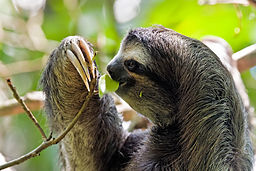Rainforest Fungi Find Home in Sloth Hair
 Most of us have seen a cute sloth video or two on the Internet. Their squished faces, long claws, and scruffy fur make these slow-moving mammals irresistible, but our furry friends aren’t just amusing Internet sensations. Like most inhabitants of the rainforest, little is known about the role sloths play in the rainforest ecosystem.
Most of us have seen a cute sloth video or two on the Internet. Their squished faces, long claws, and scruffy fur make these slow-moving mammals irresistible, but our furry friends aren’t just amusing Internet sensations. Like most inhabitants of the rainforest, little is known about the role sloths play in the rainforest ecosystem.
Three-toed sloths live most of their lives in the trees of Central and South American rainforests. Rainforests are some of the most biodiverse ecosystems in the world and home to a wide variety of organisms, some of which can be found in rather unusual places.
Due to their vast biodiversity, rainforests have been the source for a wide variety of new medicines, and researchers of this PLOS ONE study sought to uncover whether sloth hair may also contain potential new sources of drugs that could one day treat vector-borne diseases, cancer, or bacterial infections. Why look in sloth fur? It turns out that sloths carry a wide variety of micro- and macro-organisms in their fur, which consists of two layers: an inner layer of fine, soft hair close to the skin, and a long outer layer of coarse hair with “cracks” across it where microbes make their homes. The most well-known inhabitant of sloth fur is green algae. In some cases, the green algae makes the sloth actually appear green, providing a rainforest camouflage.
In the study, seventy-four separate fungi were obtained from the surface of coarse outer hair that were clipped from the lower back of nine living three-toed sloths in Soberanía National Park, Panama, and were cultivated and tested for bioactivity in the lab.
Researchers found a broad range of in vitro activities of the fungi against bugs that cause malaria and Chagas disease, as well as against a specific type of human breast cancer cells. In addition, 20 fungal extracts were active in vitro against at least one bacterial strain. The results may provide for the first time an indication of the biodiversity and bioactivity of microorganisms in sloth hair.
Since sloths are moving around in one of the most diverse ecosystems in the world, it’s possible that they may pick up “hitchhikers,” so the researchers can’t be sure how these fungi came to live on the sloth fur. They may even have a symbiotic relationship with the green algae. However the fungi ended up in the fur, the authors suggest their presence in the ecosystem provides support for the role biodiversity plays both in the rainforest and potentially our daily lives.
Image: Bradypus variegates by Christian Mehlführer
